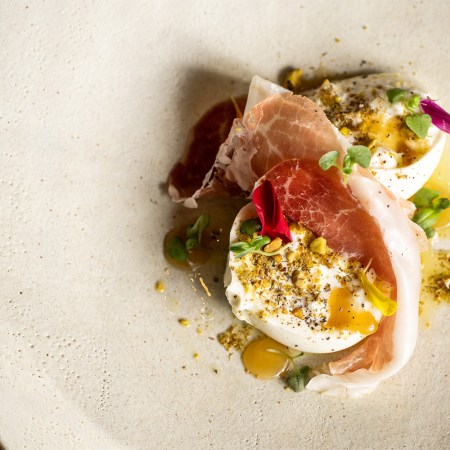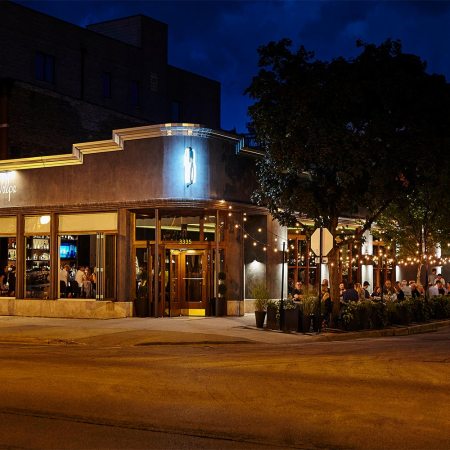Biking around my home of Portland, Oregon, this summer, I could almost fool myself into forgetting that we were in the midst of a deadly pandemic. After the stillness of spring, a time of stay-at-home orders and eerily quiet streets, the city had come back to life. The secret? Doing things outside.
While we flattened the curve through rigorous social distancing, researchers determined that transmission of the coronavirus was much less likely to occur in open-air environments. Cities responded by loosening restrictions on outdoor socializing. Though dining rooms and bars often remained closed, we enjoyed an efflorescence of tables and chairs scattered into parking spaces, alleys, rooftops and sidewalks. It was fun, refreshing, European and, alas, temporary.
For business owners blessed with the space, resources and climate to pull it off, outdoor dining offered an essential lifeline in a year that’s been absolutely brutal to the hospitality industry. But for much of the country, especially in the north, the predictable struggle to keep it going in the colder months was never far from mind. Speaking to restaurateurs about the coming change in season, they were likely to quote forebodingly from A Game of Thrones: “Winter is coming.”
With temperatures dropping and rain and snow on the horizon, many businesses have been putting up more substantial structures to shelter diners from the elements. These range from simple umbrellas and heaters to massive communal tents, the latter often so thoroughly enclosed as to raise the question of whether they meaningfully count as being outdoors at all. Some cities have issued guidance about how to adapt outdoor dining for cold weather, while for others it’s a free-for-all.
Those of us who love bars and restaurants are thus faced with a dilemma. The seemingly carefree ease of al fresco dining in the summer has been replaced by difficult tradeoffs between comfort and safety. We want to help our favorite places survive the winter, but we’re on our own when it comes to evaluating the risks of various outdoor dining set-ups. Where is one to begin?
For insight into that question, I reached out to Dr. Alex Huffman, an aerosol scientist at the University of Denver. Before getting into questions about specific outdoor structures, he was quick to emphasize the importance of local conditions: “A really, really big piece is how bad the COVID situation is in a community,” he says. Regardless of whether you’re indoors or outdoors, there’s some inherent risk in going out among other people, and that risk increases where there’s a high rate of infection. “Right now, when the country is on fire with COVID, we have to do something to slow it down. That is why so many communities are considering shutting down inside and outside dining.”
Understanding the science of the spread
When outdoor dining is a viable option, it’s important to consider which kinds of setups most effectively minimize risk. For that, it helps to step back and understand the dynamics of how the virus can spread in social situations. Although we don’t like to think about it when we’re eating, all of us are constantly exhaling moisture-laden air. Whenever we breathe, speak, cough or sneeze, we expel saliva and respiratory fluids that can potentially carry the virus to a new host. Masks reduce risk by forming a barrier to these, but we can’t wear them while eating and drinking. And unless you’re on a terribly awkward first date, there’s probably a lot of talking going on when you dine out, too. Those factors combine to make bars and restaurants prime opportunities for viral transmission.
Obviously, one’s distance from an infected person is a relevant factor. According to an informative FAQ maintained by Jose-Luis Jimenez of the University of Colorado at Boulder and other leading scientists, there are two relevant scales of distance to keep in mind, which we’ll call “close proximity” and “shared air.” Close proximity is within one or two meters, which even in a restaurant with spaced-out tables would include you, anyone in your dining party and occasionally your server or waitstaff. Within this range there’s concern for particles of all sizes, including “ballistic droplets,” the unappetizing name that scientists use to describe the relatively large projectiles we expel from our mouths. Think of these as virus-carrying missiles that can land directly on another person or nearby surface. Because these droplets have enough mass to be quickly pulled down by gravity, they’re of most concern with regard to the people directly surrounding us.

“Shared air,” meanwhile, concerns smaller particles and aerosols that are light enough to remain suspended in the air for longer periods of time, with the potential to drift over greater distances than heavier droplets. This kind of transmission appears to be responsible for superspreading events in which many people are infected at once, and there are common factors that make it more likely to occur: crowding, low ventilation, lack of masking, long exposure time, people talking, yelling or singing, and, crucially, indoor environments. In summary, transmission over longer distances — from table to table at a restaurant, for example — is most probable when these aerosols can accumulate at high concentrations.
This explains part of why outdoor dining is generally safer than being inside a restaurant or bar. It’s not magic; it’s ventilation. In the constant, wide-open airflow of the great outdoors, there’s much less opportunity for infectious particles to become concentrated in the air. But what happens when we start enclosing outdoor spaces? That’s where things get complicated.
What to look for when you look for outdoor dining
“Indoors is really bad, outdoors is better, and there are gray areas in between,” says Dr. Huffman. He notes that it’s hard to generalize about various outdoor scenarios, because similar structures can have different individual dynamics. “They might look the same, but the airflow patterns are different for whatever reason. It’s difficult to say with surety that a given structure is safe.”
“If it’s outdoors and you just have umbrellas and a heater, I would feel much more comfortable with that,” he says. With one or two walls, there’s a possibility of a crosswind. But three? “I don’t feel very good about it.” Spacious three-sided tents encompassing multiple tables have become a popular option for restaurants, but Huffman does not view them as on par with true outdoor environments. He also notes that fans are not a perfect solution, as they could end up blowing infected air past some patrons. (This should go without saying, but an enclosed, four-sided space is essentially indoors, even if it’s out in the street. Don’t kid yourself.)
One affordable option for restaurants to increase safety in such spaces is to invest in a CO2 monitor. These cost around $150 and provide a rough estimate of ventilation by measuring carbon dioxide in the air, which is elevated by human exhalations. If CO2 levels remain low, that’s a good sign that fresh air is flowing. If it builds up, you definitely need to worry about shared air. (Precise figures vary, but the FAQ maintained by Dr. Marr and colleagues suggests that 400-500 parts per million of CO2 is very good. Measurements above 1,000 ppm suggest a need for greater ventilation, and spaces that reach 2,000-3,000 ppm should certainly be avoided.)
Dr. Huffman suggests that businesses should take advantage of technologies like CO2 monitors as a transparent way to advertise their air quality, noting that this could continue to be a valuable selling point even after the COVID pandemic subsides. Even so, he adds that this is not a perfect solution, as a monitor only tells you the level at the specific location of measurement. “Airflow within a structure is really hard to predict,” he says, and “it could have air pooling in one place and good flow in another. [CO2 monitoring] is a tool, but not the only piece of the puzzle.”
All of the above applies to shared outdoor spaces, but what about individualized domes, igloos, tents or yurts? By creating a separate, enclosed atmosphere for you and your companions, these do reduce the worry of infectious aerosols floating over from another party, assuming there’s adequate space between structures. That said, you still need to be smart about them and whom you share them with.
“If you’re in the structure with people in your household, that’s reasonably safe,” advises Dr. Huffman. Otherwise, you’re essentially sharing a compact indoor space for an extended period of time with no masks and lots of talking. That can very easily lead to transmission of the virus, especially given that it often spreads without detectable symptoms. (And don’t forget the servers. Are they masked? Do they spend time in the space with you, or just pass dishes in and out? This is relevant to your safety and theirs.)
One additional factor to consider for individual structures is the time between seatings. If a previous party has just departed, you don’t want to go right into the same air that they’ve been occupying. “There absolutely needs to be ventilation,” says Dr. Huffman. “If they’re not doing that, it defeats the purpose of the pod.” The amount of time needed varies with individual spaces, but he suggests fully opening them for at least 15 minutes between guests.
Ultimately, distance is the only reliable salve
As much as we emphasize ventilation, it’s also vital to remember that it’s just one factor of many that can help control the spread of the virus. It’s not an excuse to abandon other effective measures, particularly social distancing. Though we yearn to see friends and family, close proximity (such as sharing a table) increases risk regardless of whether you’re indoors, in a semi-enclosed space or outside.
“Whether through droplets or a concentrated plume of aerosols, people are much more likely to be infectious when you’re really close to them,” says Dr. Huffman. “Distancing is still very important. It’s an underappreciated aspect of what people need to consider in any situation.”

Unfortunately, by any realistic assessment, the winter ahead is going to be bleak. Combating the virus will require many of us to be more isolated than we’ve been in months. The hospitality industry, already battered, is headed for another major retraction, this time likely without anything like the Paycheck Protection Program loans that helped keep businesses afloat over the summer. Worst of all, modeling suggests that the United States may soon see more than 2,000 COVID deaths per day, a peak not reached since the grim first wave of the pandemic.
It’s up to each of us to balance our real and very human needs for social contact with our duties as responsible citizens to deny the virus opportunities to spread. If we’re smart, outdoor dining can make that balance a little more bearable. But that’s contingent on remaining vigilant on other fronts, suppressing infections and keeping our contacts tightly limited. If you do go out, be careful who you do it with and prioritize dressing warm to brave the elements over finding shared, sheltered spaces more likely to spread the virus.
If you don’t or cannot go out but have the financial means, you can still support local bars and restaurants. Buy takeout. Buy delivery. Buy gift cards. And no matter what, tip generously. As rough as the next few months are going to be, effective vaccinations and warmer weather are arriving with the spring. We just have to help each other get there.
This article was featured in the InsideHook newsletter. Sign up now.






















